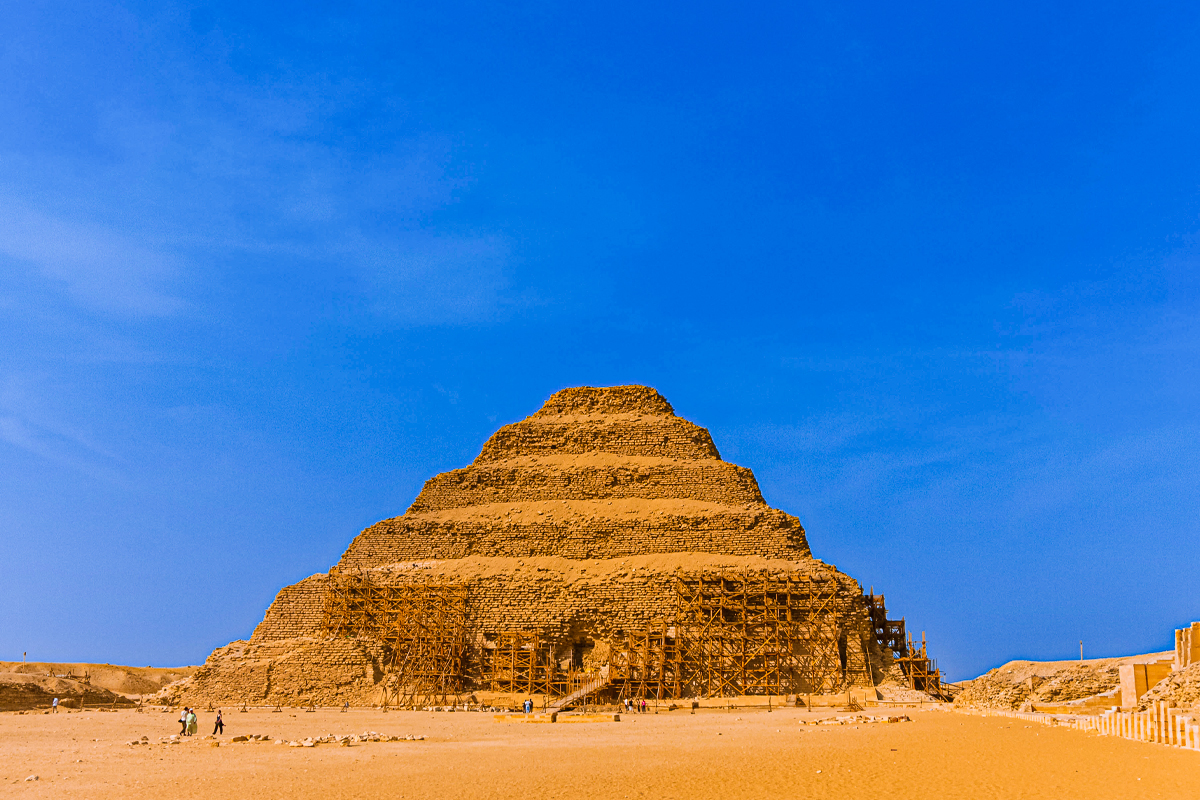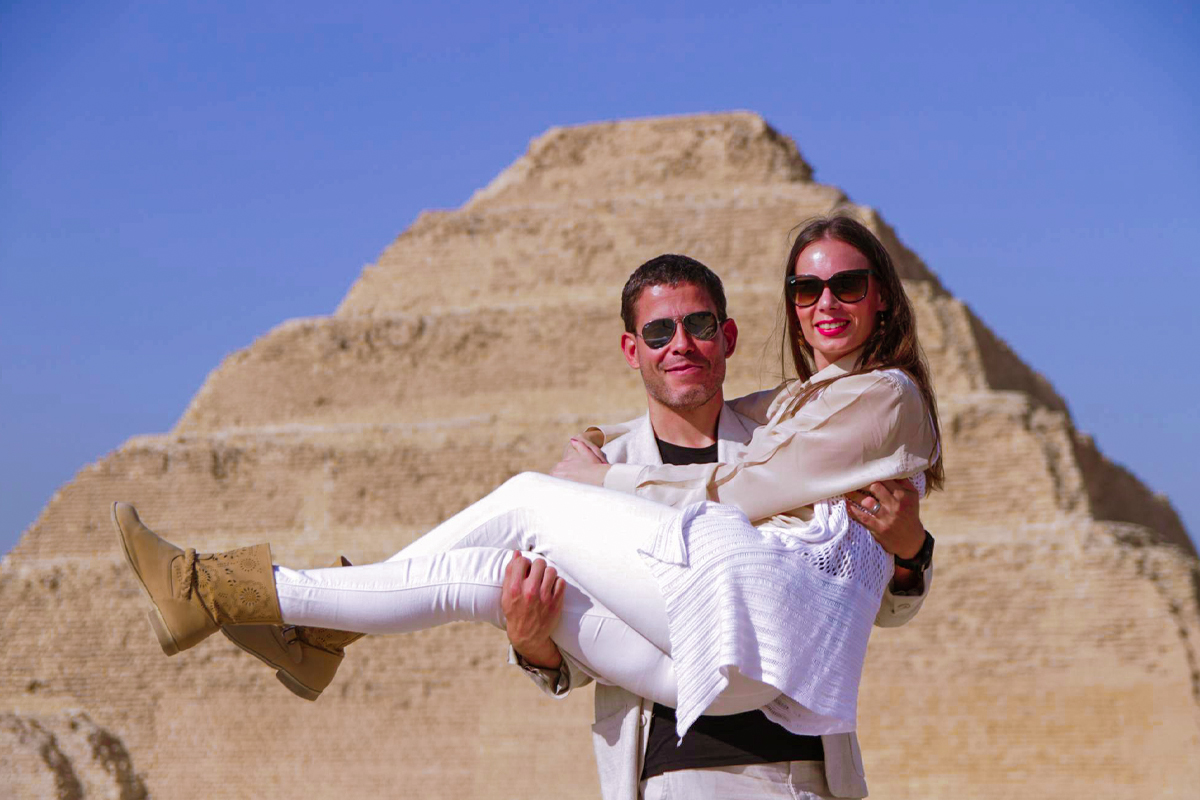The Pyramid of Djoser, also known as the Step Pyramid, is one of the most famous structures in Egypt’s rich history. Built during the 27th century BCE, the Pyramid of Djoser is the oldest known pyramid in the country and served as the burial place for Pharaoh Djoser. This impressive structure stands over 200 feet tall and comprises six distinct levels, each with its unique design and architectural features.
The importance of the Pyramid of Djoser cannot be overstated. It is widely considered one of the earliest examples of monumental architecture and engineering, showcasing ancient Egyptian builders’ remarkable skills and expertise. Beyond its historical significance, the Pyramid of Djoser also holds cultural and religious importance for the people of Egypt, symbolizing the country’s past and its enduring legacy.
In this blog post, readers can expect to learn more about the history and significance of the Pyramid of Djoser and the design and construction techniques used to build this awe-inspiring structure. We will delve into the pyramid’s cultural and religious significance and explore its role in ancient Egyptian society.
Additionally, we will take a closer look at the various levels of the pyramid and the unique features that distinguish them from one another.
By the end of this blog post, readers will have gained a deeper understanding of one of Egypt’s most iconic landmarks. They will be able to appreciate the incredible skill and ingenuity that went into its construction. Whether you are an avid history buff or simply someone curious about ancient architecture, the Pyramid of Djoser is sure to captivate and inspire.

History of the Pyramid of Djoser
The Pyramid of Djoser, also known as the Step Pyramid, was built during the reign of Pharaoh Djoser, who ruled from 2670 BCE to 2640 BCE. It was designed by Imhotep, a high-ranking official in Djoser’s court, widely regarded as one of the most important architects in Egyptian history. Imhotep’s design for the pyramid was groundbreaking, as it was the first to be built entirely of stone and to rise in a series of steps, creating the distinctive “step” shape that gives the pyramid its name.
The construction of the Pyramid of Djoser was a massive undertaking involving thousands of workers and an extensive network of resources. The limestone blocks used to construct the pyramid were quarried from nearby sites and transported to the site by boat and sleds. The workers who built the pyramid were organized into teams and were responsible for specific tasks, such as cutting and shaping the stone blocks or hauling them into place.
The Pyramid of Djoser holds great historical significance, representing a turning point in Egyptian architecture and burial practices. Before the pyramid’s construction, pharaohs were buried in mastabas, flat-roofed rectangular structures that were not as grand as the pyramids. The Pyramid of Djoser set a new standard for pharaonic tombs, inspiring the construction of larger and more elaborate pyramids in the following centuries. Its design and construction techniques also influenced other ancient civilizations, including the Greeks and Romans.
Explore the remarkable legacy of the Pyramid of Djoser and its pivotal role in shaping ancient Egyptian civilization. Discover how this architectural marvel reflects the innovations of the Third Dynasty and invites us to appreciate the rich history it represents.

The Architecture of the Pyramid of Djoser
The Pyramid of Djoser is a remarkable example of ancient Egyptian architecture, designed and constructed to serve as the final resting place of Pharaoh Djoser. The pyramid comprises several key elements, each of which plays a significant role in its overall structure and design.
The most distinctive feature of the Pyramid of Djoser is its step-like shape, which sets it apart from other pyramids in Egypt. This unique design results from a series of six mastabas, or flat-roofed rectangular structures, stacked on top of each other to create a pyramid-like shape. The result is a pyramid that rises in six distinct steps, with each level slightly smaller than the one below it.
In addition to the step pyramid, the Pyramid of Djoser includes a mortuary complex designed to serve as a center for pharaonic worship and ritual. The mortuary complex includes several key features, including a courtyard, a temple, and several smaller pyramids, each dedicated to a member of Djoser’s court. The purpose of the complex was to provide a place for the pharaoh’s spirit to reside after death and a center for worship and offerings.
One of the most important features of the mortuary complex is the serdab, a small chamber that contains a life-sized statue of the pharaoh. The purpose of the serdab was to allow the pharaoh’s ka, or life force, to reside in the statue after death. The statue was placed in a niche in the wall of the serdab, which was sealed with a stone block after the statue was placed inside. The serdab was an essential part of the Pyramid of Djoser’s design, as it allowed the pharaoh’s spirit to continue to reside in the world of the living even after death.
Overall, the Pyramid of Djoser is a stunning example of ancient Egyptian architecture, featuring a unique design and a complex system of structures and features designed to serve the pharaoh’s needs both in life and in death. Its construction was a major turning point in Egyptian history, setting the standard for pharaonic tombs for centuries to come.
What to Expect When Visiting the Pyramid of Djoser
Visiting the Pyramid of Djoser is an unforgettable experience for anyone interested in ancient Egyptian history and architecture. Before visiting, it’s essential to know what to expect regarding location, accessibility, admission fees, and what visitors can see and do at the site.
Located in the Saqqara necropolis, about 30 km south of Cairo, the Pyramid of Djoser is easily accessible by car or public transportation. Visitors can also opt to take a guided tour, which is recommended to appreciate the historical and cultural significance of the site fully.
Admission fees for the Pyramid of Djoser vary depending on the ticket type and the visitor’s nationality. As of 2023, the cost of a regular ticket for foreigners is 160 Egyptian pounds, while students and children receive a discount. The site is open daily from 8 am to 4 pm, with the last entry at 3 pm.
Visitors to the Pyramid of Djoser can expect to see various historical and architectural features, including the step pyramid, the mortuary complex, and the serdab. In addition to exploring the site’s essential features, visitors can also learn about the history and significance of the pyramid through on-site signage and guided tours.
To fully appreciate the site, visitors should plan to spend several hours at the Pyramid of Djoser. It’s also important to note that the site can be quite hot and dusty, so visitors should dress appropriately and bring sunscreen, water, and a hat. Overall, visiting the Pyramid of Djoser is a once-in-a-lifetime experience that shouldn’t be missed by anyone interested in ancient Egyptian history and culture.

Other Sites to See Near the Pyramid of Djoser
While the Pyramid of Djoser is certainly the highlight of the Saqqara necropolis, many other important historical sites exist in the area. Visitors to the Pyramid of Djoser should take some time to explore these nearby sites, including the Saqqara Necropolis, the Imhotep Museum, and the Bent Pyramid and Red Pyramid.
The Saqqara Necropolis is a vast ancient burial ground that contains the tombs of many important Egyptian figures, including pharaohs, priests, and nobles. The site has numerous pyramids, tombs, and other architectural features, including the Pyramid of Teti, the Tomb of Mereruka, and the Serapeum.
The Imhotep Museum, named after the architect who designed the Pyramid of Djoser, is an important cultural institution showcasing various ancient Egyptian artifacts and exhibits. Visitors can see a variety of sculptures, pottery, and other items from throughout Egypt’s long and storied history.
Finally, visitors to the Pyramid of Djoser should also take some time to explore the nearby Bent Pyramid and Red Pyramid. These two pyramids are notable for their unique architectural features, including the bent shape of the Bent Pyramid and the red limestone used to construct the Red Pyramid. Both pyramids are well worth a visit for anyone interested in ancient Egyptian architecture and history.
Overall, there is much to see and do around the Pyramid of Djoser. Visitors should plan to spend at least a full day exploring the various historical sites in the area and can easily spend several days taking in all that Saqqara has to offer. Whether you’re interested in ancient history, architecture, or culture, the Pyramid of Djoser and its surrounding sites are not to be missed.
In conclusion, the Pyramid of Djoser is a fascinating historical site that holds immense importance in the history of ancient Egypt.
From its unique structure to the intricate mortuary complex and serdab, there is much to learn and appreciate about this architectural wonder. Visitors to the site can expect a memorable experience, with opportunities to explore the pyramid and its surroundings and learn more about the history and culture of Egypt. It is important to note that the site is easily accessible, with transparent admission fees and opening hours.
In addition to the Pyramid of Djoser, there are other nearby sites to visit, such as the Saqqara Necropolis, the Imhotep Museum, and the Bent Pyramid and Red Pyramid. We highly recommend exploring these sites to better understand and appreciate ancient Egyptian history and architecture. Overall, the Pyramid of Djoser is a must-visit destination for anyone interested in history, architecture, and culture. We hope this blog post has provided useful insights and inspiration for your future travels to Egypt.
